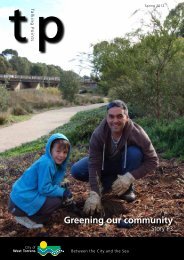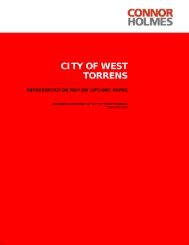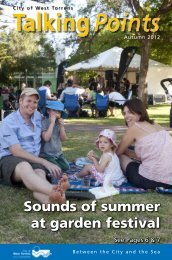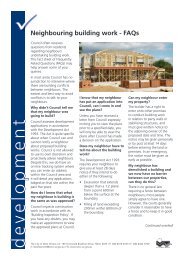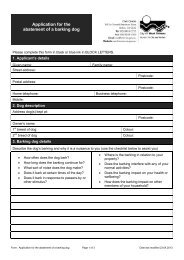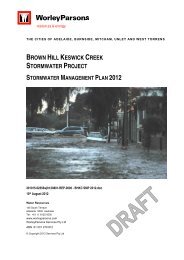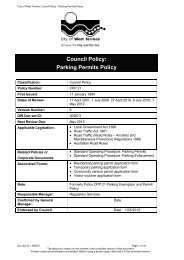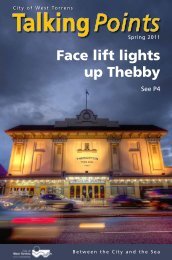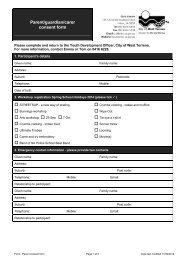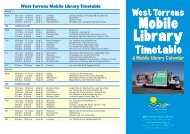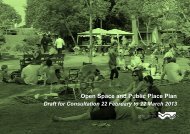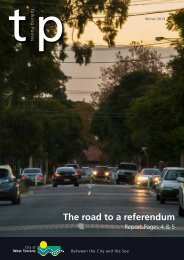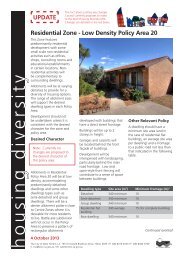Recommendations - City of West Torrens - SA.Gov.au
Recommendations - City of West Torrens - SA.Gov.au
Recommendations - City of West Torrens - SA.Gov.au
You also want an ePaper? Increase the reach of your titles
YUMPU automatically turns print PDFs into web optimized ePapers that Google loves.
and the South Australia Police, 6 Council<br />
roads were nominated and approved for<br />
DTEI for B Double gazettal:<br />
• Ashwin Parade<br />
• Richmond Road<br />
• London Road<br />
• Scotland Road (part)<br />
• Manchester Road (part)<br />
• Smith Street (part)<br />
The above roads have been<br />
incorporated for a number <strong>of</strong> years<br />
by DTEI into the gazetted B Double<br />
network which does note require<br />
permits to operate on by B Doubles<br />
(refer to FIGURE 6).<br />
The <strong>City</strong> has also approved B Double<br />
access on a number <strong>of</strong> other local roads<br />
by annual permit. Each application for<br />
B Double access is assessed on merit<br />
before approval is given.<br />
DTEI’s Heavy Vehicle Access<br />
Framework<br />
The source <strong>of</strong> the following<br />
information on restricted access<br />
vehicles is from the report, Heavy<br />
Vehicle Access Framework (HVAF)<br />
Version 1 report July 2006 by DTEI.<br />
The HVAF has been developed to<br />
provide industry with the necessary<br />
guidelines for sustainable long-term<br />
planning and transport operations. The<br />
HVAF provides the policy and direction<br />
for meeting the main objectives <strong>of</strong><br />
South Australia’s Strategic Plan for<br />
heavy vehicle operation.<br />
Restricted Access by Gazette Notice<br />
Restricted Access Vehicles (RAVs) can<br />
only operate on approved routes due<br />
to their large size and mass.<br />
It is recognised that transport efficiency<br />
40<br />
Part 1 - Overview | Freight<br />
can be improved by the use <strong>of</strong> larger<br />
vehicles with greater carrying capacity.<br />
South Australia has adopted the<br />
Restricted Access Vehicle concept<br />
within State legislation to make the<br />
most efficient use <strong>of</strong> the existing road<br />
network infrastructure.<br />
As some RAV types, such as Road<br />
Trains and B-Doubles, are built to a<br />
common design and configuration,<br />
their construction specifications<br />
and general rules <strong>of</strong> operation are<br />
specified in the Road Traffic Act and<br />
related Regulations.<br />
Due to their size and mass, these<br />
RAVs are only permitted to travel on<br />
routes approved as safe and suitable in<br />
accordance with nationally consistent<br />
road assessment standards.<br />
Controlled Access Buses for<br />
carrying passengers are also included<br />
in this category.<br />
RAVs can only operate legally in South<br />
Australia in accordance with specified<br />
conditions and on approved routes<br />
either by Gazette Notice or Permit.<br />
Another category <strong>of</strong> RAV is Special<br />
Purpose Vehicles (SPVs). These vehicles<br />
are designed and built to undertake<br />
specific tasks and functions generally<br />
as machines on wheels not as freight<br />
carrying vehicles. Typical SPVs are<br />
front-end loaders, fork-lifts, mobile<br />
cranes and grain-harvesting machines.<br />
Due to their unique design, SPVs,<br />
in many cases, do not comply with<br />
vehicle standards or the general access<br />
width, height, length or axle mass<br />
limits. Consequently, they operate<br />
under strict conditions such as daylight<br />
travel only and no travel during peak<br />
periods in urban areas.<br />
In recent times, the <strong>Gov</strong>ernment has<br />
also allowed by regulation the use <strong>of</strong><br />
14.4m long buses on the main road<br />
network. The current regulation for<br />
rigid vehicles specifies a maximum<br />
length <strong>of</strong> 12.5m for such a vehicle.<br />
However, in view <strong>of</strong> disabled access<br />
requirements, many passenger buses<br />
now have to increase in length from<br />
12.5m to 14.4m to accommodate<br />
the disabled access requirements. As<br />
a consequence, the <strong>Gov</strong>ernment has<br />
had to gazette the use <strong>of</strong> 14.4m buses<br />
as a matter <strong>of</strong> urgency.<br />
At this stage, the <strong>City</strong> has not<br />
<strong>au</strong>thorised the use <strong>of</strong> 14.4m<br />
buses on local roads controlled by<br />
the Council and which form part <strong>of</strong><br />
a regular bus route. This is due to<br />
concern about existing traffic control<br />
devices and local intersections not<br />
being able to accommodate the<br />
longer-length buses and the changes<br />
that may be required for bus stops<br />
and bus bay locations. A few specific<br />
routes (to bus company depots) have<br />
been supported and approved by the<br />
<strong>City</strong> and these were based on merit<br />
and detailed assessment by DTEI,<br />
which demonstrated that the local<br />
roads used for access did not<br />
require alterations.<br />
Strategic Approach to classify<br />
freight networks<br />
A detailed response from the <strong>City</strong><br />
<strong>of</strong> <strong>West</strong> <strong>Torrens</strong> on the HVAF report<br />
was prepared in September 2005.<br />
This Council Agenda report and<br />
the minutes adopted have been



